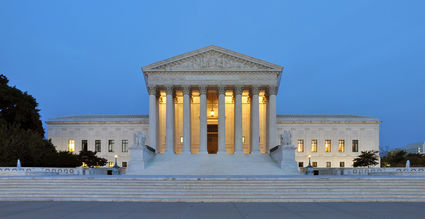National Park laws are different in Alaska
Sturgeon case shows NPS regulations do not apply to inholdings
Last updated 9/25/2020 at 2:38pm

Joe Ravi; Creative Commons 3.0
The unanimous U.S. Supreme Court decision in the John Sturgeon case will likely require the National Park Service to revisit its regulation of mineral activities on Native corporation inholdings within national park boundaries in Alaska.
Alaska is different - it has moose hunters on hovercrafts, many large national parks, and certain unique federal laws. On March 26, the U.S. Supreme Court unanimously held that National Park Service laws and regulations of general applicability do not apply to inholdings within Alaska's national parks. Sturgeon v. Frost, 587 U.S. ___ (2019).
While on a moose hunting trip twelve years ago, Sturgeon was repairing his hovercraft on a section of the Nation River within the Yukon-Charley Rivers National Preserve (a unit of the National Park System) when park rangers ordered him to stop using the hovercraft in the preserve. Sturgeon left that day without the benefit of his hovercraft and without a moose.
He later sued, arguing that the Park Service ban on hovercrafts did not apply to the Nation River, a navigable river the bed of which is owned by the state of Alaska.
This case arose under the Alaska National Interest Lands Conservation Act of 1980 (ANILCA).
When the federal government designated national park lands in ANILCA, it swept tracts of nonfederal lands – state, Alaska Native corporation, and private inholdings – within the park boundaries.
ANILCA provides that no state, Native, or private inholdings "shall be subject to the regulations applicable solely to public lands within [conservation system] units." Nonetheless, the federal government claimed that the Park Service could regulate the inholdings like park lands.
The U.S. Supreme Court disagreed with the Park Service and ruled that Park Service regulations do not apply to nonfederal inholdings within national parks in Alaska. Because the state of Alaska, not the United States, holds title to the submerged lands under navigable rivers running through national parks established after statehood, those submerged lands are not "public lands" under ANILCA. Second, the Supreme Court found that ANILCA also eliminated the Park Service's authority (that it has in the Lower 48 states) to enforce national park regulations on these non-public inholdings.
This case demonstrates that the U.S. Supreme Court will require the Park Service to recognize that Congress established different laws for Alaska.
This decision's broader impacts remain to be seen. The U.S. Supreme Court expressly did not address the Ninth Circuit's Katie John subsistence cases. It is also unclear what effect Sturgeon may have on patented or unpatented federal mining claims in national parks in Alaska under the Mining in the Parks Act of 1976. But this decision will likely require the Park Service to revisit its regulation of mineral activities on Native corporation inholdings within national park boundaries in Alaska.
EDITOR'S NOTE: This article was originally published by Stoel Rives LLP at JD Supra, a noted online source for legal content, and is being republished by North of 60 Mining News with minor format changes. Stoel Rives cautions that the information provided in this article may not be applicable in all circumstances and should not be acted upon without specific legal advice based on particular situations.




Reader Comments(0)